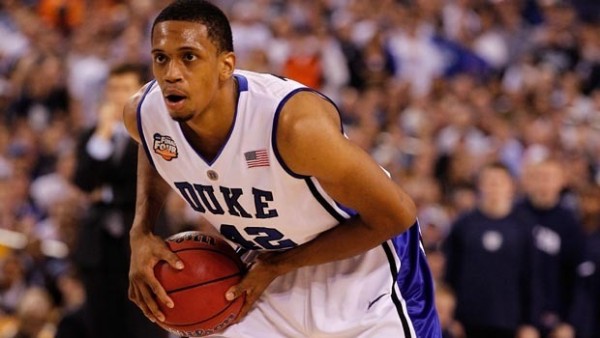Lance Thomas Reaches a Settlement Deal: Is the NCAA Rendered Powerless In Its Investigation?
Posted by Chris Johnson on September 19th, 2012Chris Johnson is an RTC columnist. He can be reached @ChrisDJohnsonn.
The chances that former Duke forward Lance Thomas did not commit some kind of NCAA violation when he purchased $98,700 worth of jewelry on a December road trip to New York City during his senior season are, shall we say, doubtful. Thomas, a starting role player on the Blue Devils’ eventual National Championship-winning team in 2009-10, walked into world-renowned jeweler Rafaello & Co., dropped a $30,000 down payment on a host of diamonds and other trinkets, then promised to pay the remaining $67,800 within the next 15 days. His spending spree – the specifics of which were released last week when word leaked of the firm’s lawsuit against Thomas – raised many eyebrows. It is not every day that student-athletes – from the most well-off to those struggling to stay afloat on hefty financial aid packages/scholarships – walk into celebrity-hotspot jewelers and splash nearly $100,000 on buckets of iced-out swag; not without drawing the analytical glare of NCAA staffers, not without an explanation as to how or where the money came from, nor whether any third parties were involved in the transaction. Given the bare facts, it was hard not to come away thinking Rafaello & Co would entrust someone like Thomas with such for any other reason than an assumed stipulation of future NBA riches and the subsequent jewelry spending they prefigure. Thomas never made good on his promise, and so Rafaello & Co., after waiting more than two years for him to repay the loan, demanded he break even on his credit. On Tuesday, the Raleigh News and Observer reported that the two parties had reached a settlement on the matter.

If neither Thomas nor Rafaello & Co. come clean with specifics, the NCAA may be impotent in pursuing the case (Photo credit: Jonathan Daniel/Getty Images).
Now that Thomas’ outstanding debt has been settled, there are legitimate concerns that NCAA investigators will have no grounds on which to pursue information regarding the former Duke player’s involvement in this transaction. The NCAA cannot compel members outside its jurisdiction to cooperate, meaning neither Thomas nor Rafaello & Co. can be forced to speak with the organization about his purchase. There’s one caveat. A conversation between ESPN.com’s Andy Katz and Indianapolis attorney Stu Brown, a legal specialist focusing on NCAA cases, shed some light on the NCAA’s procedural wherewithal. The terms of the settlement – which may or may not ever become public – may permit Thomas or Rafaello & Co. to speak with NCAA investigators, but if the legal ramifications mandate either or both to keep quiet on the specifics of their transaction, the NCAA will likely have no substantial recourse to find clarity in what on its face appears to be a blatant violation of amateurism. From Katz’s story:
Brown said if the settlement agreement prevents any comment to a third party (which would include Duke and the NCAA), then “it is likely that this case will eventually fade away due to an absence of relevant information/evidence about what really happened.”
When the details of Thomas’ diamond splurge first made headway on blogs and message boards and forums across the country last week, fans of other schools were licking their lips at the inevitable NCAA wrecking ball heading the Blue Devils’ way. They were thrilled at the idea of seeing Coach K’s unassailable fortress of student-athlete morality feel the wrath of some kind of crippling sanction, not to mention a decided slight on the program’s sterling reputation for recruiting not just great basketball players but equally clean citizens. Thomas’ alleged misconduct represented a crack in the armor, a clear-cut case for NCAA investigators to come down on the gold standard for all things college hoops. But unless either party here comes forward with the details (why would they?), or a third party presents credible knowledge of the details (who?), the NCAA will most likely be rendered powerless in its investigation. Duke will certainly continue to work with the governing body to unearth evidence of any possible violation, but if the NCAA can’t find enough evidence through its conversations and investigatory work with school officials, this thick cloud of alleged malfeasance may very well end up as more smoke than fire. Duke, America’s college basketball whipping boy, may emerge unscathed.
Time hasn’t run out quite yet: the NCAA has until December 21, 2013 (the date the statute of limitations tolls) to present Duke with any specific bylaw infractions. It needs clear evidence, though, before taking any punitive actions against the program. In the meantime, the organization will continue to seek out any leads or viable sources on the case. But If the NCAA is indeed unable to prove Thomas used his influence as a Duke basketball player to secure financial assistance for his jewelry purchase, the Blue Devil program will get off without even the slightest punitive wrist slap, flawless reputation in tow. There will be no small measure of negative backlash, especially if the NCAA manages to crack down on Duke’s powder blue rivals residing eight miles down US 15-501 for their role in a potential wide-ranging academic scandal. Duke isn’t out of the clear, but their future looks far rosier than it did when Thomas’ purchase first surfaced nearly two weeks ago.












































